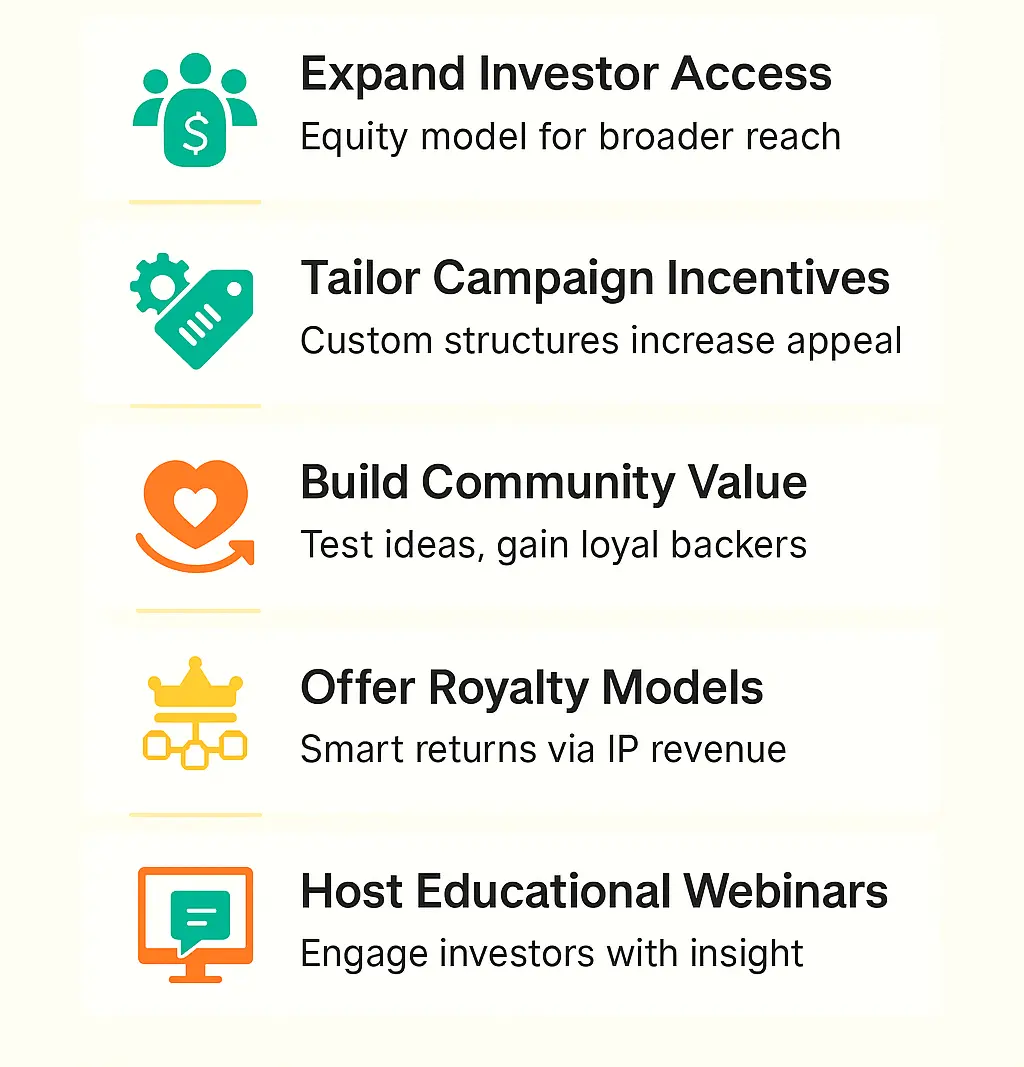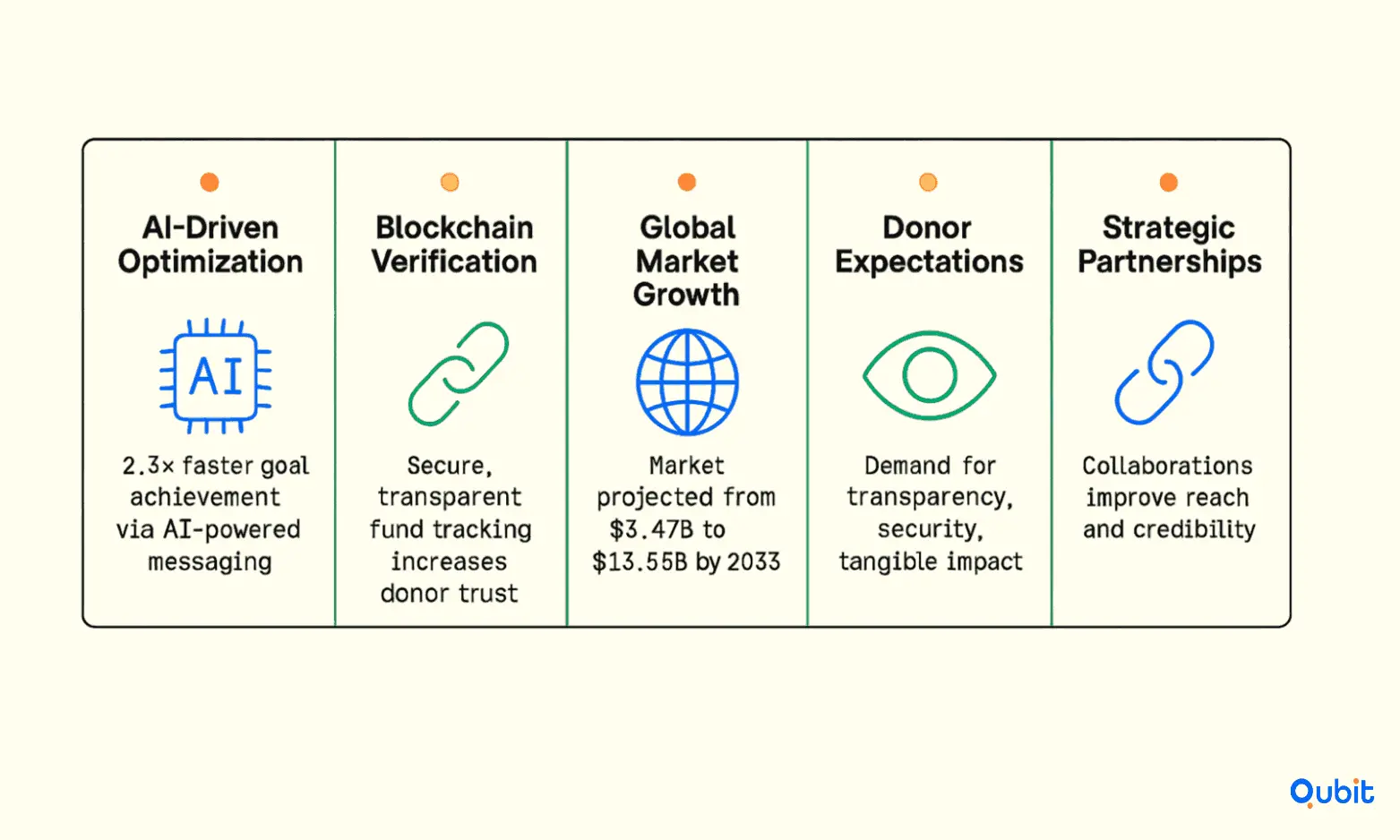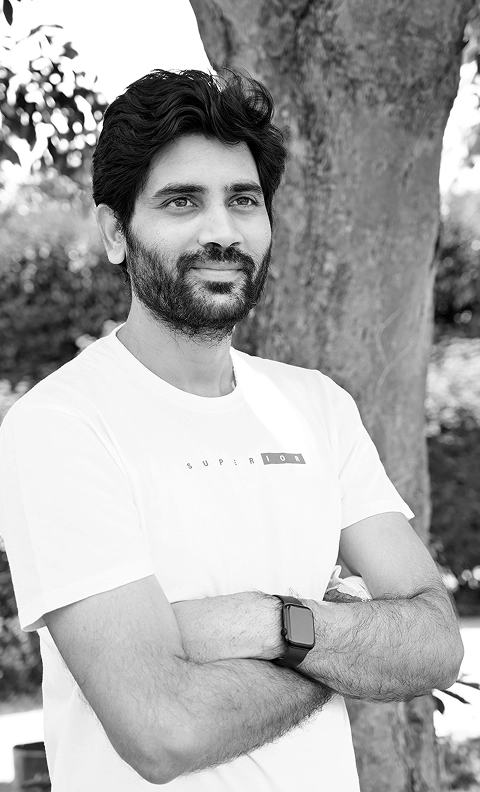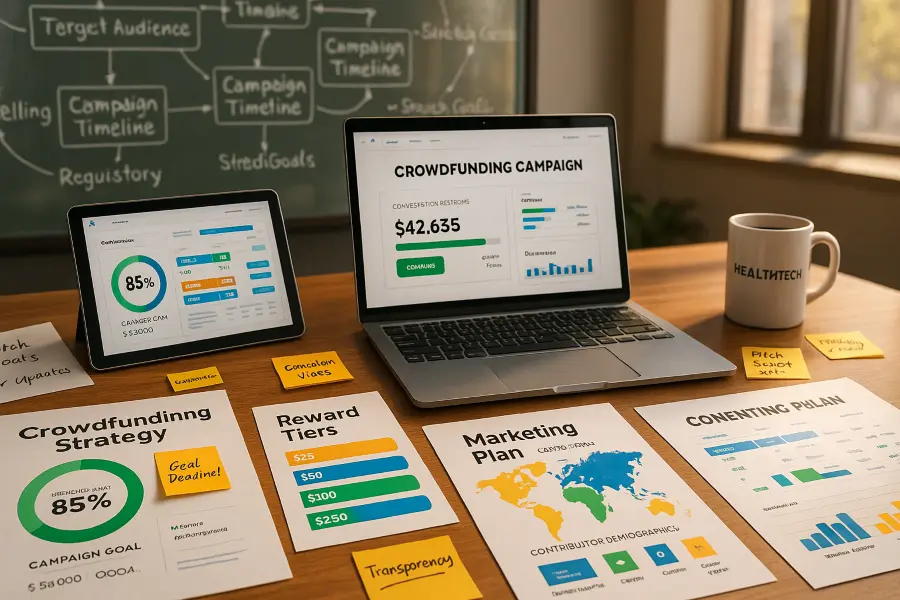HealthTech crowdfunding has emerged as a transformative way for startups to secure funding while building a community of early supporters. This approach allows innovators to connect directly with individuals who believe in their vision, bypassing traditional funding barriers.
Global crowdfunding market reached $17.2 billion in 2023, growing at a 15.82% annual rate. This rapid expansion underscores increased founder opportunity. For HealthTech startups, participating in this growth means greater access to capital and supporters.
In this article, we’ll guide you through the essentials of crowdfunding in the HealthTech space. From understanding its benefits to exploring regulatory insights and real-world success stories, this comprehensive guide will equip you with the tools to launch a successful campaign. Let’s dive into the strategies that can turn your innovative ideas into reality.
Why Crowdfunding Matters for HealthTech Startups
Crowdfunding enables HealthTech startups to raise capital, validate market need, and build community support, offering faster access and democratized funding compared to traditional methods.
- Democratized Access to Capital: Crowdfunding enables startups to raise funds from a broad audience, reducing dependence on venture capital or institutional investors.
- Market Validation: Successful campaigns demonstrate real-world demand, helping startups attract further investment and partnerships.
- Community Engagement: Founders can build a loyal base of users, patients, and advocates who support product development and adoption.
- Speed and Flexibility: Many platforms offer fast payouts and campaign customization, vital for time-sensitive medical innovations
For HealthTech founders, crowdfunding campaign targets now range from $50,000 to $124,000. This defined scope lets early-stage startups realistically reach capital milestones while engaging hundreds of supporters.
Equity crowdfunding expands investor access beyond traditional VCs, allowing startups to reach a broader pool of contributors. This approach democratizes investment opportunities, enabling individuals to support innovative HealthTech solutions. Platforms like StartEngine and SeedInvest have proven effective for startups aiming to raise funds while fostering community engagement.
Crowdfunding may not suit all HealthTech ventures, especially those with high regulatory risk or limited public appeal. Consider timing, market saturation, and legal complexity before launching. Your exploration of crowdfunding options gains depth when you consider how to secure funding for healthcare startups, which provides the foundational framework for diverse financing methods.
Crowdfunding Strategies for HealthTech Startups
Regulation A+ campaigns raised over $244 million. This demonstrates equity crowdfunding's ability to eclipse traditional capital sources, giving HealthTech companies broader investor access and higher raise potential.

1. Equity Crowdfunding: Expanding Investor Access
Equity crowdfunding expands investor access beyond traditional VCs, allowing startups to reach a broader pool of contributors. This approach democratizes investment opportunities, enabling individuals to support innovative HealthTech solutions. Platforms like StartEngine and SeedInvest have proven effective for startups aiming to raise funds while fostering community engagement.
2. Innovative Campaign Strategies
Successful crowdfunding campaigns often rely on creative approaches to attract and retain investor interest. Sen-Jam Pharmaceutical, for instance, raised over $3M by incorporating fractional royalty rates into its campaign. This innovative incentive structure appealed to investors seeking tangible returns, demonstrating how tailored strategies can drive substantial fundraising achievements.
Additionally, HealthTech startups can enhance their campaigns by emphasizing their unique value propositions. Highlighting the societal impact of their solutions, such as improving patient outcomes or streamlining healthcare processes, can resonate deeply with potential investors.
3. Benefits Beyond Funding
Crowdfunding offers more than just financial support. It serves as a low-risk method to test market interest and refine product offerings based on investor feedback. Moreover, campaigns often result in a loyal community of backers who champion the startup’s mission, amplifying its reach and credibility.
4. Fractional Royalty Incentives and Blockchain Transparency
Fractional royalty rates offer a compelling way for HealthTech startups to incentivize investors beyond traditional equity. By sharing a portion of future licensing revenue, startups can align investor interests directly with product success. This model is particularly effective for medical device and pharmaceutical innovations, where intellectual property generates ongoing income streams.
Blockchain technology enhances the transparency and efficiency of fractional royalty contracts. Smart contracts automate royalty payments, ensuring investors receive their share promptly and accurately. This approach reduces administrative burden and increases trust among backers, as all transactions are securely recorded and verifiable.
5. Educational Webinars for Investor Engagement
Educational webinars provide HealthTech startups with a direct channel to communicate their vision, progress, and milestones to potential investors. These sessions allow founders to address questions, showcase product developments, and clarify regulatory pathways in real time. By fostering transparency, webinars help build investor confidence and encourage repeat participation.
Hosting regular webinars demonstrates commitment to open communication and ongoing education. Investors appreciate opportunities to interact with founders and healthcare experts, deepening their understanding of the startup’s mission and technology. This engagement can lead to stronger community support and increased funding momentum.
Emerging Healthcare Innovation Trends
The healthcare industry is undergoing a transformative shift, driven by advancements in technology and digital tools. Telemedicine, wearable devices, and AI diagnostics are reshaping how care is delivered, making it more accessible and personalized. These innovations are not just enhancing patient outcomes but are also redefining the very structure of healthcare delivery systems.
1. Telemedicine: A New Era of Care Delivery
Telemedicine has emerged as a cornerstone of modern healthcare, offering patients the ability to consult with healthcare providers remotely. By 2020, over 76% of U.S. hospitals were using telehealth solutions, according to the American Hospital Association. This widespread adoption highlights the critical role of telehealth in HealthTech's digital transformation. It ensures that patients, regardless of location, can access timely medical advice, reducing barriers to care.
2. The Rise of Wearable Health Devices
Wearable devices are another game-changer in healthcare innovation. Products like Fitbit are empowering individuals to monitor their health metrics in real time. These devices not only provide valuable data to users but also validate the clinical impact of HealthTech platforms. The wearable health device market is experiencing rapid growth, with forecasts predicting significant expansion in the coming years. This trend underscores the increasing demand for tools that enable proactive health management.
3. AI Diagnostics: Precision and Efficiency
Artificial intelligence is revolutionizing diagnostics by offering unprecedented accuracy and efficiency. From analyzing medical images to predicting patient outcomes, AI-driven tools are enhancing the decision-making process for healthcare providers. These advancements are particularly impactful in early disease detection, where timely intervention can save lives.
Artificial intelligence secured 62% of all digital health funding. This dominance highlights AI's central role in advancing healthcare precision and efficiency.
The rapid adoption of telehealth, the growing popularity of wearable devices, and the integration of AI diagnostics collectively emphasize the importance of digital transformation in HealthTech.
Navigating Regulatory and Funding Pathways
Understanding regulatory crowdfunding options is essential for startups seeking to secure funding while adhering to compliance standards. Each pathway offers distinct advantages tailored to different growth stages and financial goals.
1. Exploring Reg A+ Funding
Companies can raise up to $75 million annually through Reg A+, which makes it ideal for ambitious startups. This pathway supports large-scale growth.
Reg A+ saw 61 offerings closed, with 34 new campaigns launched. This activity underscores the pathway's relevance for scaling HealthTech ventures. For HealthTech startups, Reg A+ can be particularly advantageous, as it supports larger capital raises and fosters credibility in competitive industries. If your startup has already gained traction and is prepared to scale, this pathway can be a strategic choice to fuel growth.
2. Reg CF for Early-Stage Startups
Reg CF (Regulation Crowdfunding) is an SEC rule allowing startups to raise up to $5 million via online platforms. This approach is especially beneficial for startups that prioritize agility and want to test market interest before pursuing larger funding rounds. HealthTech startups can use Reg CF to validate their ideas, build a community of supporters, and establish a foundation for future growth.
From FDA (U.S. Food & Drug Administration) compliance to HIPAA (Health Insurance Portability and Accountability Act) requirements, these hurdles demand meticulous attention to ensure both operational integrity and investor confidence. Addressing these challenges early in the process is essential for securing funding and building trust.
Scaling Beyond Crowdfunding
Once initial funding rounds like Reg CF or Reg A+ are complete, startups often look to escalate their financial strategies. An advanced financial approach is outlined in Series A funding strategies for HealthTech, deepening your understanding of scaling startup financing beyond initial crowdfunding rounds.
By aligning your fundraising strategy with the right regulatory pathway, you can maximize your startup’s potential while ensuring compliance. Whether you’re aiming for rapid growth through Reg A+ or seeking flexibility with Reg CF, these pathways provide tailored solutions for HealthTech startups at every stage.
From Crowdfunding Success to IPO: A Case Study
Crowdfunding has become a powerful tool for startups aiming to scale, and NantKwest’s journey exemplifies how this approach can lead to remarkable outcomes. Transitioning from crowdfunding to IPO, the company raised over $207 million, proving that early investor engagement can significantly influence public market confidence.
1. Strategic Campaigns: The Foundation of Success
NantKwest’s story highlights the importance of well-planned crowdfunding campaigns. By focusing on clear milestones, the company not only attracted initial funding but also built a strong foundation of trust with its early supporters. This trust translated into credibility, which played a pivotal role in securing the confidence of public market investors.
The transition from crowdfunding to IPO is rarely straightforward. NantKwest’s ability to identify decisive strategic pivots was instrumental in its success. For instance, the company’s focus on HealthTech funding success allowed it to align its goals with market demands, ensuring long-term growth.
2. Milestones and Pivots: Key Drivers
Achieving an IPO requires more than just funding; it demands a roadmap of clear milestones. NantKwest’s journey underscores the importance of setting achievable goals and adapting to challenges along the way. Each milestone served as a stepping stone, demonstrating the company’s progress and potential to both private and public investors.
For startups in the HealthTech sector, understanding the broader investment ecosystem is crucial. An examination of venture capital for HealthTech startups extends your understanding of the investment ecosystem, highlighting subsequent steps after a successful crowdfunding campaign.
Risks and Considerations
- Platform Fees and Payouts: Compare costs, payout timelines, and support services before choosing a platform.
- Regulatory Compliance: Ensure your campaign and product meet all legal and data privacy standards.
- Campaign Visibility: Success often depends on proactive marketing and outreach—viral campaigns are rare without strategic promotion
Overcoming Regulatory Challenges in HealthTech Crowdfunding
HealthTech startups often encounter regulatory complexities that can significantly influence their crowdfunding campaigns. From FDA compliance to HIPAA requirements, these hurdles demand meticulous attention to ensure both operational integrity and investor confidence. Addressing these challenges early in the process is essential for securing funding and building trust.
1. Understanding Key Regulatory Barriers
The regulatory landscape for HealthTech startups is shaped by stringent requirements. FDA approval is often necessary for products classified as medical devices or pharmaceuticals, requiring extensive documentation and clinical trials. Similarly, HIPAA compliance is critical for ventures handling sensitive patient data, ensuring privacy and security protocols are robust. These regulations, while essential for public safety, can pose significant obstacles for startups aiming to launch quickly and efficiently.
Compliance attracts investor interest. Health sector’s venture capital share grew from 21% in 2018 to 32% in 2024. This market shift rewards startups prioritizing regulatory strategy.
2. Strategies to Overcome Regulatory Challenges
Engage Regulatory Experts Early
Collaborating with professionals who specialize in FDA and HIPAA regulations can streamline compliance efforts. Their expertise helps identify potential pitfalls and ensures that your crowdfunding campaign aligns with legal standards. This proactive approach minimizes delays and builds credibility with investors.Transparent Communication with Investors
Clearly outlining your regulatory strategy in crowdfunding materials reassures potential backers. Investors are more likely to support ventures that demonstrate a thorough understanding of compliance requirements and a commitment to meeting them.Consider Alternative Funding Models
For startups struggling with regulatory complexities, exploring alternative funding strategies can be beneficial. An analysis of bootstrapping a HealthTech startup offers insight into self-funding approaches that bypass some of the challenges associated with regulated crowdfunding.
3. Building Investor Trust Through Compliance
Successfully navigating regulatory challenges not only ensures legal adherence but also strengthens investor confidence. Demonstrating a clear plan for FDA approval, HIPAA compliance, and clinical trials showcases your commitment to quality and safety. This transparency fosters trust, making your campaign more appealing to potential backers.
Emerging Trends in HealthTech Crowdfunding
The landscape of HealthTech crowdfunding is evolving rapidly, driven by innovative technologies and shifting donor expectations. Staying ahead of these trends is essential for campaigns aiming to maximize their impact.

1. AI-Powered Campaign Optimization
Artificial intelligence is revolutionizing how crowdfunding campaigns are designed and executed. By analyzing donor behavior and campaign performance, AI tools can refine messaging and target the right audience with precision. Campaigns utilizing AI-driven crowdfunding strategies have been shown to achieve their goals 2.3 times faster, while also increasing the average donation size. Combining AI-driven analytics with compelling messaging can significantly shorten campaign timelines, making it a game-changer for HealthTech initiatives.
2. Blockchain Verification Systems
Trust remains a cornerstone of successful crowdfunding, and blockchain technology is emerging as a powerful tool to enhance transparency. By enabling secure and immutable tracking of funds, blockchain fosters donor confidence and encourages larger contributions. Campaigns that integrate blockchain in crowdfunding have reported higher average donation amounts, underscoring the technology’s potential to transform donor engagement. Applying blockchain for transparent tracking of funds can boost credibility and donation size, creating a win-win for both campaigners and contributors.
3. A Growing Global Market
Looking ahead, global crowdfunding is projected to grow from $1.45 billion in 2024 to $5.43 billion by 2033. This expansion highlights fresh opportunities for HealthTech founders entering the market. Such robust growth depicts the market’s increasing acceptance of crowdfunding mechanisms, making it an exciting time for HealthTech entrepreneurs and investors alike.
For those looking to position their campaigns for success, exploring broader financial opportunities can provide valuable insights. A broader view on financial opportunities is presented in how to invest in the HealthTech industry, offering complementary insights to the nuances of crowdfunding.
Conclusion
Crowdfunding has evolved into a dynamic tool for startups, offering diverse pathways to secure funding while simultaneously validating market demand. From understanding regulatory guidelines to exploring innovative trends like equity crowdfunding and reward-based campaigns, the strategies discussed highlight the importance of tailoring your approach to your audience and goals.
A compelling narrative-driven campaign remains the cornerstone of success. By crafting a story that resonates with backers, startups can build trust, inspire action, and achieve their funding targets. Beyond financial support, a well-structured campaign can also serve as a powerful validation of your product or service in the marketplace.
If you’re looking to convert early traction into a fully funded campaign, at Qubit we understand list-building, creator updates, and perk design. Strengthen your round through our healthcare fundraising assistance services and connect with our team today.
Key Takeaways
- Diverse crowdfunding pathways enable HealthTech startups to secure community-driven funding.
- Navigating regulatory nuances with strategies like Reg A+ and Reg CF is essential.
- Real-world case studies highlight effective campaign strategies and milestones.
- Emerging trends such as AI diagnostics and blockchain integration boost campaign performance.
- Collaborative innovation initiatives drive industry transformation and global engagement.
Frequently asked Questions
What is Reg A+ funding in HealthTech crowdfunding?
Reg A+ funding allows HealthTech startups to raise up to $75 million annually through public investment, offering scalability and broad investor access.






